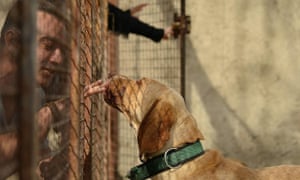
I called Maryam Sanei in Tehran a little before 9pm. She had asked me to call her at night, saying she was busy during the day taking care of her dogs, which she calls “kids”.
After a few rings, she picked up, sounding anxious. “I can’t talk right now. We have a kid here who’s badly injured. Can I talk to you in few hours?” She got back to me at 1.30am.
The injured dog, who had now been named Kimia, was found in Lavasan, north east of Tehran. Straying onto a road, a car had left her jaw and one of her legs fractured. Sanei admitted Kimia to her eponymous hospice located in Chahardangeh City in Tehran province, and started raising funds through social media for the surgery. A few days later, Kimia had an operation on her jaw.
Sanei, 37, originally studied at the Civil Aviation Technology College in Tehran to become a flight attendant, but her love for animals led her in a different direction. In April 2012, when Sanei was living with her family in the northern province of Mazandaran, she started taking care of injured animals, mainly dogs. As she had no resources or a shelter, she launched a Facebook page to publicise each case and ask for funds to treat the pooch.
A few months later, Sanei moved to Tehran and decided to work more seriously. By then she had more Facebook followers, with some of them offering to look around for donations. “I decided to focus on dogs with terrible problems, for example badly injured or handicapped ones, those nobody would get close to and were therefore doomed to die,” she says. “People who knew me would call and let me know about these cases. I would go and take care of the initial treatment. Then we would put their photos on Facebook and let people know how much money we needed to treat them.”
Without a shelter, Sanei would ask her Facebook followers for a temporary home: “One would offer a basement, the other would empty a room and another would say, ‘Put it in my parking lot’. They would host the kid and I would take care of the rest, including taking the kid to the vet.”
Even though people were offering to host some of the dogs, Sanei was short of places. She had to take some of them to a pension and pay for their stay. After a while she couldn’t afford the costs. “At one point I took hold of 14 female terriers that were used for breeding,” she recalls. “They were all sick, so I put them all in a pension. In the end I was left with debts of 23 million tomans” - or $7,600.
It was in the middle of her financial struggles that an American woman, who had been in contact only a few times through Facebook, sent more than $3,000. That helped Sanei rent a 1,000 sq-metre piece of land in Chahardangeh, in the south west of Tehran province in December 2014 and open a hospice for dogs. She started with seven dogs and now has more than 60, even though she says the capacity is 40. Her initial plan was to bring in injured dogs, take care of them until recovered and then set them free and make space for other injured dogs. But with municipality workers killing stray dogs, she won’t let them go until they have a home.
No comments:
Post a Comment